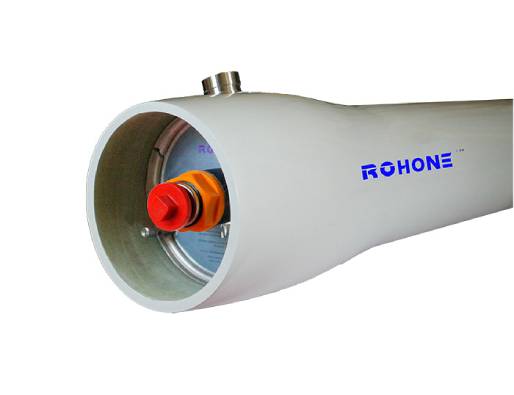After understanding the membrane fouling mechanism, the importance of the lateral flow velocity of the feedwater for reducing pollution and maintaining the production water flux is very clear. A higher lateral velocity can increase the degree of turbulence of the water flow, reduce the accumulation of particulate matter in the gaps of the screen and the precipitation on the membrane surface. The higher lateral velocity also increases the diffusion rate of high-concentration salt at the membrane surface, reduces the harm of concentration polarization, reduces the thickness of the boundary layer, and prevents the precipitation and scaling of insoluble salts at the membrane surface.
The lateral velocity of the membrane surface is determined by factors such as the water supply flow rate, the width and thickness of the water supply channel of the membrane element. The thicker the water supply channel, ie the water supply screen, the higher the lateral velocity is required to achieve the same degree of turbulence and the effect of the boundary layer, and the higher lateral flow rate requires a higher water supply flow rate. The smaller the membrane area in the same membrane element, this means that in order to achieve a more suitable lateral flow rate of the membrane surface, the membrane element with a small membrane area (water supply screen thickness) needs to bear a large feed water flow, resulting in a unit membrane area Water production load, that is, increased water flux, will inevitably increase the degree of membrane pollution.
The above analysis shows that in order to reduce pollution, maintain water flux and prolong the cleaning cycle, the appropriate thickness of the water supply grid should be selected. Under certain specific conditions, the use of a thinner feedwater grid thickness can effectively increase the lateral flow velocity and improve the overall performance of reverse osmosis membrane pressure vessels.
Some membrane manufacturers advocate the use of thicker membrane elements for water supply screens (for example, a nominal thickness of 0.031 inches and a membrane area of 330 square feet). They claim that this membrane has a low tendency to foul, which can reduce the cleaning frequency and increase the cleaning effect. Although Hyde can also produce this kind of membrane element, it mainly promotes membrane elements with a feedwater screen thickness of 0.028 inches, membrane area of 365 square feet and 400 square feet. Field application experiments show that the membrane element with a thickness of 0.031 inches and a membrane area of 330 square feet has no obvious advantages in terms of pollution resistance.
A semiconductor factory located in the southwestern United States has also conducted this comparative experiment. The plant feed water contains higher concentrations of organic matter and colloidal particles. They also used Hydeon's membrane area of 400 square feet, a reverse osmosis membrane housings with a 0.028-inch screen thickness, and other companies' membrane areas of 330 square feet, with a screen thickness of 0.031-inch. Membrane element. The results show that when operating under the same conditions, the pollution rate of these two membrane elements and the recovery rate of water flux after cleaning are basically the same.

Reverse Osmosis Membrane Housings
In fact, first of all, when the feedwater flow rate is determined, the lateral velocity of the membrane element with a thickness of 0.031 inches is lower than that of the membrane element with a feedwater screen of 0.028 inches. In a reverse osmosis system with the same membrane area and other process parameters being the same, the lateral flow velocity of the system with thicker feedwater grid is lower, resulting in a higher membrane fouling rate. Secondly, for reverse osmosis systems with the same feedwater flow rate and produced water flow rate and the same number of membrane elements used, when using membrane elements with a smaller membrane area (thick feedwater grid), the system's produced water flux, namely The water production load per unit membrane area is relatively large, resulting in an increase in membrane fouling speed. For example, the membrane area of 400-square-foot and 365-square-foot membrane elements is 10.6% and 21% larger than that of 330-square-foot membrane elements, respectively. In systems using the same number of membrane elements, systems using 330-square-foot membranes have less membrane area , Resulting in high water flux and high water supply pressure. The water production flux greatly increases the pollution trend, and the high feed water pressure increases the feed water pump cost and power consumption. Another option available at this time is to increase the number of membrane elements (and pressure vessels), but this in turn increases equipment costs.